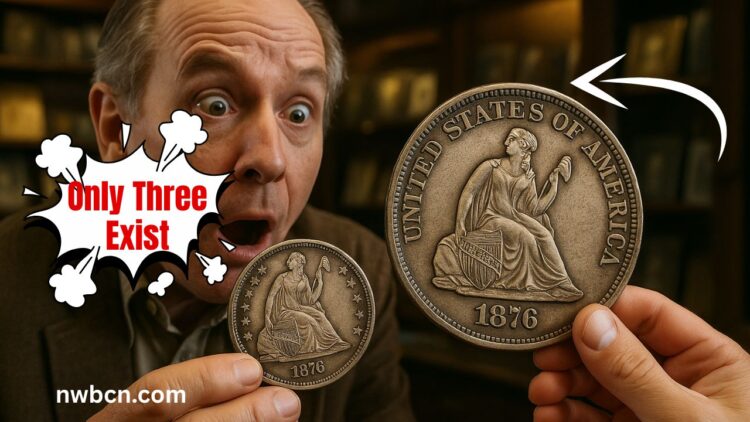The 1876‑CC 20‑Cent piece, often nicknamed the “double dime,” is one of the most scarce and fascinating coins in American numismatics. Struck at the Carson City Mint (mint mark CC) in 1876, just 10,000 coins were made—and nearly all were melted in 1877 by order of Mint Director Henry Linderman.
Today, only 12–20 examples are known, with just three pristine, high-grade specimens surviving. Values range from six-figure collections to an MS‑65 beauty that sold for $690,000 in 2024.
Why the 1876‑CC 20‑Cent Piece Almost Disappeared
- Mintage and purpose: Authorized by Congress to ease small change shortages in the West, 10,000 pieces were struck June 1–17, 1876 at Carson City.
- Confusion and rejection: The coin mimicked the quarter in size and design, leading to public confusion. By 1878, Congress revoked its legal tender status.
- Ordered destruction: In March 1877, Linderman directed the melting of remaining stock in Carson City vaults—nearly the entire 1876‑CC mintage—effectively erasing the coin from circulation.
Surviving Survivors: Mere Dozens Left
| Category | Quantity |
|---|---|
| Original mintage | 10,000 |
| Confirmed survivors | 12–20 total |
| Mint-state survivors (MS+) | ~3 specimens |
| Circulated survivors | Few sighted—most examples are uncirculated |
The extremely low survivor count, especially in mint state, gives 1876‑CC its legendary status.
Auction Records and Value
The coin’s value is breathtaking. High-grade examples regularly fetch six-figure sums, with MS‑65 coins reaching nearly $700,000.
| Year | Grade | Auction Price (USD) | Commentary |
|---|---|---|---|
| 2024 | MS‑65 (PCGS) | $690,000 | Heritage’s ANA Signature top lot |
| Recent | MS‑64+ | $350,000–$600,000+ | Mid-grade mint-state specimens |
| Any MS | MS63–MS66 | $168,000–$1.15M | Greysheet range |
| VF–EF | Circulated | $50,000–$200,000 | Quality-dependent but still high |
Historical Impact and Numismatic Appeal
- Brief commercial life: Intended to compensate for regional shortages but failed due to similarity with the quarter.
- Carson City’s legacy: CC-mint examples are highly sought after, and this piece is the rarest of all.
- Assay Commission origin? Experts believe most survivors were assays, not circulation, making circulated examples even more extraordinary.
Grading and Collecting Tips
- Authenticity: Check sharp “CC” mintmark under the eagle on the reverse.
- Condition matters: Graded MS‑64 and above coins are rarities. Certification by PCGS or NGC is essential to confirm condition and legitimacy.
- Provenance adds value: Documented history, pedigrees, or inclusion in major collections significantly enhance worth.
- Compare rarity: Even VF specimens regularly lie in the high five-figure range—mint state elevates them into six figures.
1876‑CC 20‑Cent Highlights
| Feature | Detail |
|---|---|
| Mintage | 10,000 |
| Survival Estimate | 12–20 total survivors |
| Mint-state survivors | ~3 MS‑63+ coins |
| Peak Auction | $690,000 (MS‑65, 2024) |
| Value Range | $50,000 (VF) to $1.15M (MS‑66+) |
| Melted By Order | March 1877, Lester removal by Linderman |
| Design | Seated Liberty obverse; eagle reverse by Barber |
| Composition | 90% silver, 10% copper; 5.00 g weight, 22 mm diameter |
Why It’s a Must-Have (If You Can Find One)
- Rarity legend: With fewer than 20 total survivors and only three mint-state examples, it’s a draconic rarity among U.S. coins.
- Historical enigma: Represents a transitional and short-lived denomination tied to Western shortages and Mint policy.
- Investment allure: Proven resale values in six figures—and forecasts suggest continued growth in value.
- Carson City legacy: Adds regional minting cachet to its broader mystique.
The 1876‑CC 20‑Cent Piece isn’t just rare—it’s a living artifact of Western frontier economics, Mint hubris, and collector mythology. With only a dozen total survivors and record prices pushing toward $700K, it stands as one of the rarest and most valuable American coins. For those who manage to acquire one, it’s truly a numismatic crown jewel.
FAQs
Q1: How many 1876‑CC Twenty‑Cent pieces are known?
Between 12 and 20 total survivors, with just three mint-state examples.
Q2: Why did most of the mintage get melted?
Mint Director Henry Linderman ordered the melt in March 1877 after poor public reception and the coin’s short-lived legal tender status.
Q3: Are circulated examples valuable?
Yes—though they are rarer than mint-state survivors. Even VF–EF examples can command $50,000 to $200,000 depending on quality
